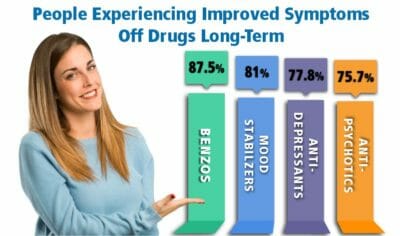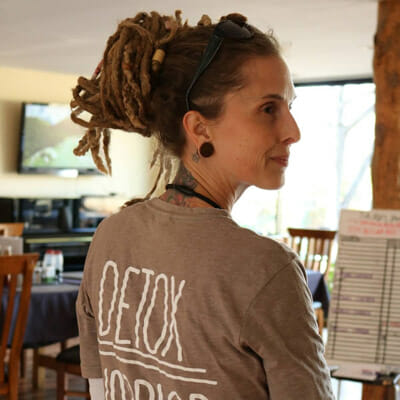Strategies for Opiate Withdrawal Success
At Alternative to Meds Center we have helped thousands of clients to achieve their goals for successful opiate withdrawal and recovery. Unlike the “safer supply” schemes that actually enable addiction, we have seen the reality of successfully freeing oneself from the trap of opiate addiction.
We employ a biophysical approach to opiate withdrawal, blended with gentle tapering, which in some cases will involve a substitution (legal) drug such as Suboxone. This will immediately reduce or eliminate the drastic physical opiate withdrawal reactions, and allow for a relaxed gentle taper to follow.
At the same time, rebuilding the natural endorphin (pain killer hormones) production by the body is accomplished by flooding the body with the raw materials that will generate new natural endorphin production. Once endorphins (including dopamine) are restored adequately, the pain and misery of withdrawals will no longer resurface even when the replacement drug has been zeroed out. References and links are provided below for your further understanding of the importance of each listed item.
Strategies for opiate withdrawal success include:
- substitution tapering protocols (medically supervised)
- temporary use of bridge medications to make withdrawal less harsh, more tolerable
- correction of diet to provide the raw materials for healing and restoration
- supplementation of raw materials the body needs for neurotransmitter rehabilitation 8-11
- physical exercise blended with comfort and holistic pain management therapies such as massage, Reiki, acupuncture, Qigong, etc. 12,15,16
- natural remedies for insomnia, mood, exhaustion, gastro inflammation, etc.13
- replenishing a dysregulated gut microbiome back to healthy state 14
- biophysical treatments such as mineral baths to replenish lost minerals, nebulized glutathione
- neurotoxin removal (drug residues, pesticides, chemicals from past exposures, etc.)
- CBT, life coaching, or other addiction counseling at an appropriate point in the recovery process
- peer support programs for ongoing support and encouragement
For a boost in hope and encouragement, please see samples of our clients’ opiate withdrawal success stories.
Traditional Methods May Miss the Mark for Opiate Withdrawal Success
Many traditional rehab centers have group-based treatment plans, and many are based on the 12-step principles. The success rate of 12-step programs has shown it does help some, and remarkably so, but perhaps not the majority for long term success.
Because the biophysical factors involved in healing after chronic drug use are not addressed and repaired, the person may be subject to fall back into needing a drug to try and remedy the physical pain, recurring cravings, or other drivers of their continuing addiction. Counseling plays another significant role as an unsatisfactory lifestyle resulting in boredom or unresolved stresses or mental anguish can also promote or drive drug use as a perceived solution. This is most commonly referred to as “relapse”, but it may be more exactly described as an attempt to extinguish the very symptoms for taking pain medication in the first place. These have not been addressed and resolved. Thus, programs that offer healing based on the strength of the group rather than as an individual may not be able to fully reach and disengage these drivers of addiction. Though the community of support can be highly beneficial, the transition from rehab to normal life may be subject to failure after leaving rehab, when it is no longer in place.
Alternative to Meds Center aims to provide uniquely tailored holistic treatments, which are the key to overcoming addiction successfully. A comfortable opiate withdrawal experience is the first step, but it is an important one to build a strong platform for sustaining a satisfying, drug-free life.
A Better Quality of Life
Alternative to Meds Center has been operating for nearly 2 decades, providing the best in evidence-based therapies and protocols for our clients successful opiate withdrawal and recovery. Each person in unique, and requires a distinctly personalized program, designed to attain freedom from the trap of addictive pain killers, but also freedom from the pain and other symptoms that required taking drugs in the first place. In many cases, the pain can be reduced significantly or eliminated altogether using the correct blend of therapies. Thus, the need for ongoing medications is reduced drastically or eliminated entirely. But it takes work, focus, and determination to succeed.
There is much to learn and know about successful recovery after opiate withdrawal and about the mechanics of opiate addiction and we encourage you to actually read the references below for greater understanding. With understanding, comes the empowerment of knowledge. Addiction is no mystery. You can also learn more in the education modules that are offered during the program.
That is why our staff are so dedicated to our clients. Many of us have been in similar straits and have recovered ourselves using holistic, health-restorative methods for long-lasting success. We are proud of the success in opiate withdrawal and recovery that we offer our clients. Please call us anytime for more information, including costs & insurance coverage, estimated length of stay, more about the beautiful surrounds of Sedona where we are located, or any other questions you or your loved one may have about recovery with us.









